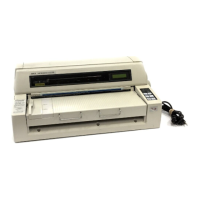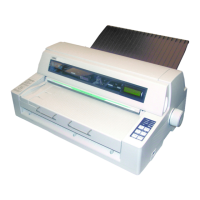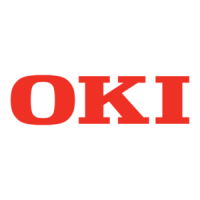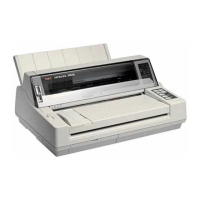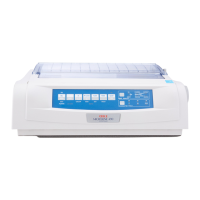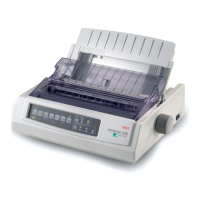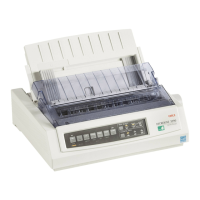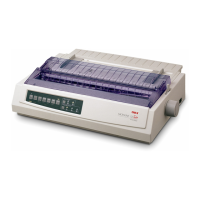Do you have a question about the Oki Microline 8480FB and is the answer not in the manual?
Lists the key features and capabilities of the Microline 8480FB printer.
Illustrates and labels the external components of the printer's front view.
Shows and labels internal components visible from the front when the cover is open.
Illustrates and labels the tractor mechanisms visible inside the printer's front.
Depicts and labels the connection ports and other features on the rear of the printer.
Details the function of each individual switch on the printer's control panel.
Explains the operation of control panel switches when pressed in combination.
Describes the status indicated by the printer's control panel lights (POWER, ALARM, etc.).
Provides a summary of key control panel operations and their corresponding button presses.
Details the use of the printer for everyday, letter-quality printing.
Explains the use of the printer for high-speed draft printing.
Describes the use of the printer for printing multipart forms, noting cautions.
Provides step-by-step instructions for switching between Normal, High Speed, and High Impact print modes.
Details how to load single sheets or forms into the printer, including specifications.
Explains how to load continuous forms into the printer, including specifications.
Describes the procedure to switch between Normal and High Impact print modes.
Explains how to switch the printer's paper path between single sheets and continuous forms.
Provides instructions on how to print the current Function Setting Menu configuration.
Explains the structure of the menu (Groups, Items, Settings) and how to access it.
Details how to navigate through the menu options using the control panel buttons.
Walks through an example of setting Proportional Spacing and Form Tear-Off in the menu.
Describes the procedure to reset all printer settings to their original factory defaults.
Provides specific instructions for printing the menu when using single sheets of paper.
Details the process for printing the Function Setting Menu using continuous forms.
Presents a summary table of all available menu groups, items, and their settings.
Adjusts the horizontal location for the first character on a form using manual feed.
Adjusts the horizontal location for the first character on a form using manual feed, with Auto Align disabled.
Adjusts the horizontal location for the first character on a form using continuous forms (front feed).
Sets custom left margin values for forms when using manual feed.
Enables automatic alignment of single sheets/forms and allows switching between preset margin values.
Detects and corrects paper skew for manual feed with Auto Align enabled.
Sets the alignment method engaged for manual feed when the printer is turned on.
Determines if a carriage return is automatically added after a line feed in IBM emulation.
Sets when the paper ejects based on the distance from the last line to the bottom of the page.
Enables automatic line feed control via pin 14 of the parallel interface.
Automatically adds a line feed after receiving a line feed.
Enables or disables the printer's audible alarm.
Selects the volume level for the printer's buzzer.
Chooses the character set for special characters in foreign languages.
Determines if data outside the normal print area is printed, with cautions about printhead damage.
Allows selection of the desired character set for the code page.
Corrects for paper curl when feeding forms manually.
Determines where paper is ejected when using manual feed.
Selects the printer emulation mode (Epson LQ, IBM PPR, IBM AGM, Diablo).
Activates the feature to advance continuous forms for tear-off without wasting paper.
Fine-tunes the Top of Form (TOF) location for continuous forms.
Sets whether the printhead gap is automatically or manually adjusted.
Provides a guide for selecting manual printhead gap settings based on paper type and thickness.
Sets the starting position for gap detection when Auto Gap is enabled.
Configures the print direction for graphics (Bi-directional or Uni-directional).
Enables a low-vibration mode to reduce printer vibration during printing.
Sets the printer to automatically start in Hi-Impact mode when turned on.
Chooses the interface mode: Auto Interface, Parallel, or USB.
Controls whether the printer prints buffer contents upon receiving an I-Prime signal.
Sets the time the printer waits before going into idle mode when Host Interface is set to Auto.
Determines paper position (print or tear) when the printer is turned on.
Selects a language set for special characters used in foreign languages.
Adjusts the line spacing in lines per inch (LPI).
Adjusts the line feed value for manual feed.
Sets the paper feed speed for inserting sheets using manual feed.
Stores the last used Auto Align setting in printer memory.
Selects print direction for double-height print lines.
Chooses the length of the manual feed paper being used.
Chooses the width of the continuous forms paper being used.
Determines printer behavior when paper end is detected during manual feed.
Selects printing usage for the parallel interface (Uni-directional or Bi-directional).
Configures whether Tear Off is engaged when switching to continuous forms path.
Fine-tunes the last line of printing location for manual feed.
Fine-tunes the last line of printing location for continuous forms (front feed).
Sets when the printer moves to the next continuous form.
Chooses the character width in characters per inch (cpi).
Sets the time before the printer enters Power Save Mode.
Enables or disables the printer entering energy-saving Power Save Mode.
Determines if commands for unidirectional printing are recognized.
Chooses print quality and speed, such as LQ Courier, Roman, Swiss, etc.
Enables print suppress mode using DC1 and DC3 codes.
Engages proportional spacing of characters.
Reduces printing noise.
Sets the amount of memory for holding received data.
Adjusts print registration for low-speed printing.
Adjusts print registration for normal-speed printing.
Adjusts print registration for high-speed printing.
Adjusts print registration for draft mode printing.
Prevents software from resetting printer settings by ignoring INITIAL commands.
Controls the Paper Set Alarm, allowing it to be disabled for forms with anomalies.
Sets pitch for 10 cpi when SI command is received in IBM emulation.
Sets pitch for 12 cpi when SI command is received in IBM emulation.
Selects Single or Double width and height printing.
Detects and corrects paper skew for manual feed with Auto Align disabled.
Configures skip over binding behavior for continuous forms and manual feed.
Sets printer behavior when it nears the bottom of the page.
Chooses between Normal and Italic style for printed characters.
Sets the starting position for printing down from the top of the page.
Fine-tunes the Top of Form (TOF) location for manual feed.
Sets the time the printer waits for paper insertion during manual feed.
Distinguishes the number zero from the capital letter O with a slash.
Provides steps to disable the Auto Align feature through the printer menu.
Explains the default Top of Form setting and its purpose.
Details how to set the Top of Form (TOF) using the printer's menu system.
Explains how to set and use custom Top of Forms for Manual Feed and Front Feed paths.
Describes how to set a temporary Top of Form (TOF) using the control panel.
Provides instructions to activate the Form Tear Off feature via the Function Settings Menu.
Details how to advance continuous forms to the tear-off position.
Performs a test printout of ASCII characters for printer functionality verification.
Prints a sample of each available font to verify font selection and output.
Enables a mode to print all received data in hexadecimal and ASCII format for debugging.
Explains the printhead gap and the factory default Auto Gap setting.
Lists manual printhead gap settings and the paper types/thicknesses they are used for.
Describes how to temporarily change the printhead gap setting using control panel switches.
Explains how to permanently change the printhead gap setting via the Function Setting Menu.
Provides instructions for clearing paper jams when single sheets are used.
Provides instructions for clearing paper jams when using continuous forms.
Offers methods to resolve recurring paper jamming issues, often caused by debris.
Lists common error messages and their corresponding solutions or required actions.
Provides a step-by-step guide for replacing the printer ribbon cartridge.
Instructs on how to clean the printer's interior housing and around the platen.
Lists printer control codes and their functions, ordered by ASCII code.
Lists printer control codes and their ASCII codes, ordered by function.
Specifies the printer's print method as Impact dot matrix.
Details the printhead specifications: 24-pin, 0.2 mm diameter, and thermal protection.
Lists the supported printer emulations: Epson LQ, IBM Proprinter, IBM AGM, Diablo.
Identifies the standard interfaces supported: Centronics Parallel and USB.
States the selectable receive buffer sizes: 0 or 128 Kbytes.
Provides approximate printing speeds based on the number of parts (pages) being printed.
Details print speeds based on pitch, thickness, and print quality settings.
Shows the number of characters per line for different cpi settings in normal and wide modes.
States the maximum graphics resolution: 360 x 360 dpi.
Lists the available fonts based on print quality settings.
Provides reliability metrics like MTBF, MTTR, printhead life, and ribbon life.
Specifies width, length, and weight requirements for single sheet paper, with notes on recycled paper.
Details width, length, and thickness requirements for individual multi-part forms.
Specifies width and weight for continuous single-part forms.
Details width and thickness for continuous multi-part forms.
Lists supported envelope types and sizes, with notes on using the sheet guide.
Provides the physical dimensions (width, depth, height) of the printer.
States the weight of the printer main body.
Outlines the operating temperature and humidity ranges for the printer.
Specifies the electrical voltage and frequency requirements for the printer.
Lists the key features and capabilities of the Microline 8480FB printer.
Illustrates and labels the external components of the printer's front view.
Shows and labels internal components visible from the front when the cover is open.
Illustrates and labels the tractor mechanisms visible inside the printer's front.
Depicts and labels the connection ports and other features on the rear of the printer.
Details the function of each individual switch on the printer's control panel.
Explains the operation of control panel switches when pressed in combination.
Describes the status indicated by the printer's control panel lights (POWER, ALARM, etc.).
Provides a summary of key control panel operations and their corresponding button presses.
Details the use of the printer for everyday, letter-quality printing.
Explains the use of the printer for high-speed draft printing.
Describes the use of the printer for printing multipart forms, noting cautions.
Provides step-by-step instructions for switching between Normal, High Speed, and High Impact print modes.
Details how to load single sheets or forms into the printer, including specifications.
Explains how to load continuous forms into the printer, including specifications.
Describes the procedure to switch between Normal and High Impact print modes.
Explains how to switch the printer's paper path between single sheets and continuous forms.
Provides instructions on how to print the current Function Setting Menu configuration.
Explains the structure of the menu (Groups, Items, Settings) and how to access it.
Details how to navigate through the menu options using the control panel buttons.
Walks through an example of setting Proportional Spacing and Form Tear-Off in the menu.
Describes the procedure to reset all printer settings to their original factory defaults.
Provides specific instructions for printing the menu when using single sheets of paper.
Details the process for printing the Function Setting Menu using continuous forms.
Presents a summary table of all available menu groups, items, and their settings.
Adjusts the horizontal location for the first character on a form using manual feed.
Adjusts the horizontal location for the first character on a form using manual feed, with Auto Align disabled.
Adjusts the horizontal location for the first character on a form using continuous forms (front feed).
Sets custom left margin values for forms when using manual feed.
Enables automatic alignment of single sheets/forms and allows switching between preset margin values.
Detects and corrects paper skew for manual feed with Auto Align enabled.
Sets the alignment method engaged for manual feed when the printer is turned on.
Determines if a carriage return is automatically added after a line feed in IBM emulation.
Sets when the paper ejects based on the distance from the last line to the bottom of the page.
Enables automatic line feed control via pin 14 of the parallel interface.
Automatically adds a line feed after receiving a line feed.
Enables or disables the printer's audible alarm.
Selects the volume level for the printer's buzzer.
Chooses the character set for special characters in foreign languages.
Determines if data outside the normal print area is printed, with cautions about printhead damage.
Allows selection of the desired character set for the code page.
Corrects for paper curl when feeding forms manually.
Determines where paper is ejected when using manual feed.
Selects the printer emulation mode (Epson LQ, IBM PPR, IBM AGM, Diablo).
Activates the feature to advance continuous forms for tear-off without wasting paper.
Fine-tunes the Top of Form (TOF) location for continuous forms.
Sets whether the printhead gap is automatically or manually adjusted.
Provides a guide for selecting manual printhead gap settings based on paper type and thickness.
Sets the starting position for gap detection when Auto Gap is enabled.
Configures the print direction for graphics (Bi-directional or Uni-directional).
Enables a low-vibration mode to reduce printer vibration during printing.
Sets the printer to automatically start in Hi-Impact mode when turned on.
Chooses the interface mode: Auto Interface, Parallel, or USB.
Controls whether the printer prints buffer contents upon receiving an I-Prime signal.
Sets the time the printer waits before going into idle mode when Host Interface is set to Auto.
Determines paper position (print or tear) when the printer is turned on.
Selects a language set for special characters used in foreign languages.
Adjusts the line spacing in lines per inch (LPI).
Adjusts the line feed value for manual feed.
Sets the paper feed speed for inserting sheets using manual feed.
Stores the last used Auto Align setting in printer memory.
Selects print direction for double-height print lines.
Chooses the length of the manual feed paper being used.
Chooses the width of the continuous forms paper being used.
Determines printer behavior when paper end is detected during manual feed.
Selects printing usage for the parallel interface (Uni-directional or Bi-directional).
Configures whether Tear Off is engaged when switching to continuous forms path.
Fine-tunes the last line of printing location for manual feed.
Fine-tunes the last line of printing location for continuous forms (front feed).
Sets when the printer moves to the next continuous form.
Chooses the character width in characters per inch (cpi).
Sets the time before the printer enters Power Save Mode.
Enables or disables the printer entering energy-saving Power Save Mode.
Determines if commands for unidirectional printing are recognized.
Chooses print quality and speed, such as LQ Courier, Roman, Swiss, etc.
Enables print suppress mode using DC1 and DC3 codes.
Engages proportional spacing of characters.
Reduces printing noise.
Sets the amount of memory for holding received data.
Adjusts print registration for low-speed printing.
Adjusts print registration for normal-speed printing.
Adjusts print registration for high-speed printing.
Adjusts print registration for draft mode printing.
Prevents software from resetting printer settings by ignoring INITIAL commands.
Controls the Paper Set Alarm, allowing it to be disabled for forms with anomalies.
Sets pitch for 10 cpi when SI command is received in IBM emulation.
Sets pitch for 12 cpi when SI command is received in IBM emulation.
Selects Single or Double width and height printing.
Detects and corrects paper skew for manual feed with Auto Align disabled.
Configures skip over binding behavior for continuous forms and manual feed.
Sets printer behavior when it nears the bottom of the page.
Chooses between Normal and Italic style for printed characters.
Sets the starting position for printing down from the top of the page.
Fine-tunes the Top of Form (TOF) location for manual feed.
Sets the time the printer waits for paper insertion during manual feed.
Distinguishes the number zero from the capital letter O with a slash.
Provides steps to disable the Auto Align feature through the printer menu.
Explains the default Top of Form setting and its purpose.
Details how to set the Top of Form (TOF) using the printer's menu system.
Explains how to set and use custom Top of Forms for Manual Feed and Front Feed paths.
Describes how to set a temporary Top of Form (TOF) using the control panel.
Provides instructions to activate the Form Tear Off feature via the Function Settings Menu.
Details how to advance continuous forms to the tear-off position.
Performs a test printout of ASCII characters for printer functionality verification.
Prints a sample of each available font to verify font selection and output.
Enables a mode to print all received data in hexadecimal and ASCII format for debugging.
Explains the printhead gap and the factory default Auto Gap setting.
Lists manual printhead gap settings and the paper types/thicknesses they are used for.
Describes how to temporarily change the printhead gap setting using control panel switches.
Explains how to permanently change the printhead gap setting via the Function Setting Menu.
Provides instructions for clearing paper jams when single sheets are used.
Provides instructions for clearing paper jams when using continuous forms.
Offers methods to resolve recurring paper jamming issues, often caused by debris.
Lists common error messages and their corresponding solutions or required actions.
Provides a step-by-step guide for replacing the printer ribbon cartridge.
Instructs on how to clean the printer's interior housing and around the platen.
Lists printer control codes and their functions, ordered by ASCII code.
Lists printer control codes and their ASCII codes, ordered by function.
Specifies the printer's print method as Impact dot matrix.
Details the printhead specifications: 24-pin, 0.2 mm diameter, and thermal protection.
Lists the supported printer emulations: Epson LQ, IBM Proprinter, IBM AGM, Diablo.
Identifies the standard interfaces supported: Centronics Parallel and USB.
States the selectable receive buffer sizes: 0 or 128 Kbytes.
Provides approximate printing speeds based on the number of parts (pages) being printed.
Details print speeds based on pitch, thickness, and print quality settings.
Shows the number of characters per line for different cpi settings in normal and wide modes.
States the maximum graphics resolution: 360 x 360 dpi.
Lists the available fonts based on print quality settings.
Provides reliability metrics like MTBF, MTTR, printhead life, and ribbon life.
Specifies width, length, and weight requirements for single sheet paper, with notes on recycled paper.
Details width, length, and thickness requirements for individual multi-part forms.
Specifies width and weight for continuous single-part forms.
Details width and thickness for continuous multi-part forms.
Lists supported envelope types and sizes, with notes on using the sheet guide.
Provides the physical dimensions (width, depth, height) of the printer.
States the weight of the printer main body.
Outlines the operating temperature and humidity ranges for the printer.
Specifies the electrical voltage and frequency requirements for the printer.
| Type | Dot Matrix Printer |
|---|---|
| Resolution | Up to 360 x 360 dpi |
| Paper Handling | Friction feed, Tractor feed |
| Printing Method | Impact |
| Connectivity | Parallel, Serial |
| Emulation | IBM Proprinter |
| Paper Width | 3 to 10 inches |
| Noise Level | 55 dBA |
| Number of Pins | 24 pins |
